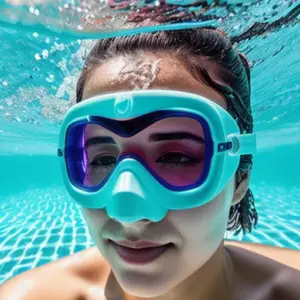Ladies, can we all agree that scheduling a beach trip or a pool party around your period feels like a Herculean task? After all, the dread of managing the relentless “plumbing issues” while swimming is intense enough to make most of us skip the event altogether. But what if I told you that the fear of swimming on your period is mostly in your head and there are simple solutions to make that time of the month a non-issue? Oh, yes! Put on your swimsuits and grab your sunscreen, because in this blog post, we’re diving head-first (pun intended) into the waters and tackling the challenges of swimming on your period. Say goodbye to missed poolside opportunities, and get ready to splash around without a care in the world!
Use a Tampon or Menstrual Cup
Swimming on your period can be a worry-free experience if you choose the right menstrual products to have a comfortable and enjoyable time in the water. The two most popular and effective options for swimming while menstruating are tampons and menstrual cups. Both of these options are safe and hygienic when used correctly and can provide leak-proof protection while swimming, allowing you to partake in water activities without any concern.
Tampons are widely considered a suitable option for swimming as they effectively absorb menstrual flow and can be discreetly worn with any swimsuit. Tampons should be changed every 4 to 8 hours, depending on your flow, to prevent toxic shock syndrome (TSS) and ensure continuous protection. If you’re a swimmer who prefers a more eco-friendly and long-lasting alternative, a menstrual cup might be the way to go. These reusable cups collect menstrual blood rather than absorbing it and can be worn for up to 12 hours at a time before needing to be emptied, cleaned, and reinserted. The menstrual cup creates a seal with the vaginal wall, making it a secure and leak-proof option for swimming.
It’s crucial to choose a product that you feel comfortable and confident using to ensure a hassle-free experience when swimming on your period. Remember, it’s perfectly natural and safe to swim during menstruation, so don’t feel discouraged from participating in your favorite water activities throughout your cycle. With the right protection in place, you can conquer the pool, beach, or lake with ease and confidence.
Swimming is Safe and Hygienic
Many women are hesitant about going swimming during their period, fearing leaks and other potential embarrassments. However, with the right precautions and knowledge, swimming while on your period is not only safe but also hygienic. In fact, it can be a great way to get some exercise, relieve menstrual cramps, and enjoy your favorite water activities without any worries.
First and foremost, it is important to know that swimming during your period is not unsanitary. The chemicals used in most swimming pools are designed to keep the water clean and help prevent the transmission of bloodborne diseases. Moreover, the small amount of menstrual blood that might leak will be heavily diluted in a pool or a lake, making it virtually undetectable.
To ensure a leak-free swimming experience, you can use internal period protection, such as tampons or menstrual cups. Tampons are made of absorbent materials like cotton or rayon, which can efficiently collect menstrual flow while you swim. On the other hand, menstrual cups are made of rubber or silicone and can be worn for 4 to 12 hours, depending on the brand. They collect the blood instead of absorbing it, making them a reusable and eco-friendly option.
If you are concerned about the tampon string being visible, you should consider using menstrual cups. Alternatively, you can opt for period-friendly swimwear, which has a built-in absorbent layer to trap menstrual blood.
wimming during your period is safe, hygienic, and enjoyable when you take the proper precautions. Don’t let menstruation hold you back from enjoying a refreshing dip in the water. Embrace the opportunity to keep active and get some relief from period discomfort while having fun in the pool or at the beach.
Exercise Can Help Improve Period Pain
Many women experience discomfort and pain during their menstrual cycle, often causing them to avoid certain activities. However, engaging in exercise can actually help to alleviate some of these period-related symptoms. Swimming, in particular, is a form of aerobic exercise that has been linked to significant improvements in period pain.
It may seem counterintuitive to engage in physical activities when experiencing menstrual cramps, but research has shown that regular exercise is beneficial for reducing pain levels. A study conducted on 70 women with primary dysmenorrhea found that those who participated in aerobic exercise for 30 minutes, three times per week, noticed a significant reduction in the severity of period pain after 8 weeks.
Swimming provides a gentle, low-impact workout that allows you to stretch out your muscles and improve blood circulation. The buoyancy of water supports your body weight, reducing the strain placed on your joints and muscles, and helping to ease discomfort caused by cramps. The warmth of the water can also help to soothe aching muscles, further promoting relaxation and relief from period pain.
If you’re experiencing debilitating menstrual cramps, it’s essential to consult your doctor, as these could be a sign of underlying health conditions like endometriosis, fibroids, or uterine polyps. In general, however, incorporating exercise like swimming into your routine can provide an effective, natural, and enjoyable way to reduce period pain and improve overall well-being during your menstrual cycle.
Menstrual Blood Does Not Attract Sharks
There is a common misconception that menstrual blood attracts sharks, potentially putting menstruating individuals at a higher risk for shark attacks. However, this myth has been debunked by scientific evidence and studies, including the International Shark Attack File. Over 80% of recorded shark bites in history have happened to men, reflecting a historic pattern of men engaging more heavily in water sports where shark encounters are more likely.
There is no doubt that sharks have a keen sense of smell, enabling them to detect blood and other bodily fluids from hundreds of yards away. However, there is no concrete evidence that menstruation specifically attracts sharks or increases the chances of shark bites. While water pressure during swimming may temporarily stop the menstrual blood flow, even if blood was to be released into the water, the amount would be minimal and would most likely not be identifiable by sharks. Additionally, human blood contains different amino acids than the blood of marine animals, which sharks have evolved to eat. This means that our blood may not even be attractive to sharks, as it does not resemble their natural prey.
In recent times, more women have become involved in water sports, which has led to an increase in female shark bite victims. However, this is not due to menstruation but rather the increased exposure to sharks. Thus, it is safe to say that menstrual blood does not attract sharks, and there is no need for individuals to avoid swimming during their period out of fear of shark attacks.
Pads Are Not Effective for Swimming
Swimming on your period shouldn’t be a cause for concern, as there are various ways to manage the situation so you can enjoy the water without worrying about leaks or discomfort. One frequently discussed option that may seem like a simple solution is using pads to absorb menstrual blood while swimming. However, wearing a pad while swimming is not recommended due to their inefficiencies and potential drawbacks.
To understand why pads are not suitable for swimming, it’s essential to know how pads work. Pads are designed to absorb your period blood, ensuring you feel dry and protected throughout the day. However, when submerged in water, pads cannot differentiate between your menstrual blood and the water around you. As a result, they quickly become saturated with water, losing their effectiveness and becoming an uncomfortable, heavy burden to wear.
Another issue with using pads for swimming is their potential to cause embarrassing leaks. Once a pad is soaked, it has very limited absorption capabilities and can no longer hold any new fluids, including your menstrual blood. In such cases, any blood flow might escape onto your swimwear, causing unsightly stains and bringing unwanted attention.
Instead of using pads, consider alternatives such as tampons or menstrual cups, which are specifically designed to be used in water without absorbing it. These options provide better protection and comfort while swimming, ensuring you can enjoy your time in the water worry-free. In conclusion, pads are not effective for swimming, and it’s best to opt for tried and tested menstrual products, including tampons and menstrual cups, for a hassle-free swimming experience during your period.

Toxic Shock Syndrome: Risks and Precautions
Toxic Shock Syndrome (TSS) is a rare but potentially life-threatening illness caused by certain types of bacteria, often associated with tampon use during menstruation. However, TSS can affect anyone, regardless of gender or age, and can also be linked to skin wounds, burns, surgical incisions, nasal packing, and intravenous drug use.
Being aware of the risks and taking precautions to prevent TSS is essential for maintaining overall health and well-being. For those who use tampons, changing them regularly (at least every four hours) can help reduce the risk of bacterial growth. It’s also important to be gentle when inserting and removing tampons, as tiny abrasions in the vaginal walls can allow bacteria to enter the bloodstream. Avoiding highly absorbent tampons and opting for pads or panty liners, especially during lighter menstrual flow days, can further minimize the risks related to tampon use.
Maintaining personal hygiene during menstruation is crucial. Washing hands thoroughly before and after handling a tampon is a simple yet effective way to prevent the spread of bacteria. Additionally, consider using pads or panty liners instead of tampons overnight to lessen the chances of bacterial overgrowth.
Although there are no clinical trials that support the use of menstrual cups to reduce the risk of TSS, they can be a viable alternative for some individuals. Nevertheless, it’s vital to follow the manufacturer’s guidelines regarding proper usage and hygiene.
It’s crucial to understand the risks and take the necessary precautions to prevent Toxic Shock Syndrome. Regularly changing tampons, practicing good hygiene, and being aware of alternative menstrual products can help minimize risks and promote better health during periods.
Menstrual Cups: Safe and Reusable
If you are looking for a safe, environmentally friendly, and comfortable alternative to traditional period products like pads and tampons, then menstrual cups might just be the perfect solution for you. Menstrual cups are small, flexible, bell-shaped devices made from Biocompatible Medical Grade Silicone or latex-free material that are inserted into the vagina to collect menstrual blood. They can be used for up to 12 hours before needing to be emptied, cleaned, and reinserted, making them a convenient and hassle-free option for people who menstruate.
One of the biggest advantages of using a menstrual cup is that it is safe for both your body and the environment. Unlike tampons and pads, which can contain harmful chemicals and contribute to significant waste, menstrual cups are made from body-safe materials and are reusable for up to 10 years. This not only helps to reduce the amount of period product waste that ends up in landfills each year, but also saves you money in the long run.
Another key benefit of using a menstrual cup is its reliability during physical activities, such as swimming. As menstrual cups create a seal with the vaginal walls, they prevent leaks and keep water from entering the cup, ensuring a worry-free swimming experience while on your period.
Lastly, menstrual cups are praised for their comfort. Once inserted correctly, many users report that they barely feel the menstrual cup and often forget that they are even menstruating. This means that you can feel confident and comfortable while participating in your favorite activities, whether you are swimming, exercising, or simply going about your daily routine.
In conclusion, menstrual cups are a safe, reusable, and eco-friendly option for period protection that offer reliable leak protection and ultimate comfort, making them an ideal choice for those who want to make a positive change for both themselves and the environment.
Using Absorbable Swimwear or Dark-Colored Suits
Many women experience apprehension about swimming during their menstrual cycle, primarily due to concerns over potential leaks or stains. However, by using absorbable swimwear or dark-colored suits, women can confidently enjoy the water without fear of accidental leakage. In this article, we’ll discuss how absorbable swimwear and dark-colored suits can provide protection and comfort for women swimming on their period.
Absorbable swimwear is a convenient option that combines the functionality of regular swimwear with the absorbency of menstrual products. Designed with a hidden leak-proof lining, these swimsuits can effectively contain menstrual blood and help prevent any embarrassing accidents while swimming. Available in various styles, such as one-piece, bikini, and high-rise options, absorbable swimwear can hold up to three tampons’ worth of blood. This makes it perfect for women with a light to medium menstrual flow or as backup protection in conjunction with a tampon or menstrual cup.
For those who prefer not to use absorbable swimwear, dark-colored swimsuits are another option that can help camouflage any potential leaks. Darker colors such as black, navy blue, or dark maroon are less likely to reveal any stains, allowing women to swim more confidently. In addition, wearing swim shorts can provide an extra layer of protection and coverage.
Delaying Your Period for Swimming
There might be instances when you want to delay your period for certain events, like a swimming competition or a vacation by the beach. While it is absolutely safe and hygienic to swim during your period with the appropriate precautions, some people may still wish to delay their menstrual cycle for their own comfort and peace of mind. Luckily, there are a few medically approved methods to safely delay your period for swimming. However, always consult with a healthcare professional before attempting any of these techniques.
1. Hormonal Birth Control: If you are already using hormonal birth control like the pill, you can manipulate your cycle by skipping the placebo pills and starting your next pack of active pills immediately. This can help delay your period by maintaining a consistent hormonal level in your body. Consult your healthcare provider if you are not currently using hormonal birth control or would like to switch methods.
2. Norethisterone: This prescription medication is a synthetic hormone that can be taken to delay your period. You typically start taking it a few days before your period is due and continue until you want your period to begin. Your period should then start within two to three days after stopping the medication. Talk to your healthcare provider to see if norethisterone is suitable for you.
3. Lifestyle Changes: While not as predictable or effective as medical approaches, making certain lifestyle changes might help in delaying your period. Maintaining a healthy weight, exercising regularly, and managing stress levels could all have an impact on your menstrual cycle.
Remember, always consult a medical professional before attempting to delay your period. It’s essential to ensure you are using the most appropriate and safe method for your specific situation.
Relax and Enjoy:Menstruation is Natural.
Swimming during one’s period can raise various concerns and questions for menstruating individuals. However, it’s essential to remember that menstruation is a natural bodily function that shouldn’t interfere with one’s enjoyment and participation in activities like swimming. Being well-informed and prepared can ensure a comfortable and worry-free experience in the water.
First and foremost, it is important to debunk the myth that one’s period stops completely while in water. Although the water pressure surrounding the vagina can counteract gravity and reduce blood flow, it does not halt menstruation entirely. Therefore, it is recommended to use some form of protection, such as tampons or menstrual cups, for maximum comfort while swimming.
There are potential benefits to swimming during menstruation, as exercise can boost endorphins and provide natural pain relief for menstrual cramps, lower back pain and PMS symptoms. Furthermore, aerobic exercise has been linked to improvements in the severity of primary dysmenorrhea, or painful menstruation, as reported by medical studies.
If concerned about blood being visible in the water or attracting sharks, rest assured that these are only myths. The average menstruating individual loses a relatively small amount of blood per cycle, making it virtually undetectable in a pool or ocean. Additionally, there is no concrete evidence to support the notion that menstrual blood attracts sharks.
In conclusion, menstruating individuals should feel confident and at ease while swimming during their period. By utilizing proper protection and being well-informed, it is possible to relax and enjoy the numerous physical and mental health advantages that swimming has to offer, regardless of one’s menstrual cycle.




